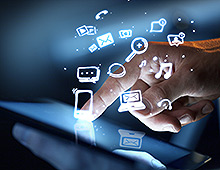According to the KPCB Internet Trends Report 2015, the number of mobile phone users in the world over is 5.2 billion, with around 40 percent being smartphone users. With tablet computers also commonplace and wearable devices along with the Internet of Things revolution just around the corner, it’s only a matter of time before the number of mobile devices far outnumbers the number of human beings on the planet.Mobile devices provide three key triggers for transformation and disruption of the status quo: Location Services, Mobile Apps and Personalization. Each of these triggers has resulted in a huge improvement in the customer experience.
Location Services: Since the user carries the mobile device, it is possible (with the user’s consent) to identify and track the location of the device. This gives rise to the opportunity to build services that use the device location, and therefore the user location; as a context to transform the customer experience.
One well-known use case is the ability to locate, track and book a taxi in the vicinity. Another use case is to find a retail outlet such as a restaurant or store that might be nearby. Alternately, a brand could send a notification to a consumer whenever she enters the ‘Geofence’ of a store. The Geofence is typically a circular, virtual perimeter set up around a region such as a store and location services can help identify when a mobile device enters or exits from the boundary of the fence. Another location service technology becoming increasingly popular is that of beacons, which can detect proximity of a mobile device at a shorter range.
Mobile Apps: What really makes smartphones ‘smart’ is the applications or apps that run on them. Mobile apps extend the functionality of the device in ways that can dramatically change the customer’s experience with any service provider.
There are several examples of how mobile apps have transformed the customer experience in the digital world. Taxi booking example earlier relies on a mobile app to help you book and track a taxi. In retail, you can use a mobile app for both online as well as in-store shopping. In travel, you can use a mobile app for holiday bookings. In healthcare, you can use mobile apps for appointments, storing your electronic medical records to the cloud, and sharing them with providers. There’s no need to go to the bank any more – you can do all your banking on your smartphone using the banking app.
Personalization: Today, sharing opinions on social media with thousands of people is literally just a tap away. Mobile devices have resulted in an explosion of consumer generated content and data. Consumer data in the digital world could be of different types: fast data, unstructured data, real-time and streaming data, large volumes of data, and so on. However data on its own has limited use. Advances in Analytics technologies and techniques are helping unlock the value in data by converting it into meaningful consumer insights.
Insights help to segment consumers and understand their behavior. Segmentation helps in personalization of the messages and communication to those consumers. Personalization and customized messaging in turn, has a direct impact on the quality of the customer experience.
Segmentation based on consumer data has always been a key marketing priority since the origins of the marketing industry. The holy grail of market segmentation can be represented by the objective “The ideal market segment should have a size of 1”. The digital age is translating this into reality.
How could the three areas above be combined? A typical use case could be in retail. A shopper in the vicinity of a store gets a notification on her mobile app that a certain item she was looking for is available; along with driving or walking directions to the store. When she enters, the app guides her to the aisle where the item is available. As she considers whether to add the item to her (electronic) shopping cart, the app asks her whether she would like a store associate to come over to help. After she adds the item to her cart, the app recommends other products she might be interested in, along with any personalized offers based on her loyalty status and past transaction history. The mobile app combined with location services as well as personalized recommendations and offers, thus becomes a “virtual personal assistant” and effectively transforms her experience in the store.
Digital Transformation is about large scale business impact. It is clear that Location Services, Mobile Apps and Personalization can individually impact the customer experience. However, in our opinion, it is necessary to combine the three in order to achieve the end objective: A Digital Transformation of the Customer Experience.
 Shantanu Paknikar is General Manager, Solution Initiatives in the IT Services division of Happiest Minds Technologies Private Limited. His expertise areas include middleware systems, Service Oriented Architecture, Business Process and Rules Management, Enterprise Integration, Cloud Computing, Social Computing, Enterprise Mobility, Business Analytics, and Distributed computing systems. He is passionate about consulting, innovation, value creation, research, and learning and how they apply in a business and corporate context. His current focus area is that of business technology solutions the applications of the intersection of multiple technologies to specific business problems. He has a Bachelor’s degree in Electronics and Telecommunications Engineering from Goa University and a Masters degree from the Indian Institute of Science, Bangalore.
Shantanu Paknikar is General Manager, Solution Initiatives in the IT Services division of Happiest Minds Technologies Private Limited. His expertise areas include middleware systems, Service Oriented Architecture, Business Process and Rules Management, Enterprise Integration, Cloud Computing, Social Computing, Enterprise Mobility, Business Analytics, and Distributed computing systems. He is passionate about consulting, innovation, value creation, research, and learning and how they apply in a business and corporate context. His current focus area is that of business technology solutions the applications of the intersection of multiple technologies to specific business problems. He has a Bachelor’s degree in Electronics and Telecommunications Engineering from Goa University and a Masters degree from the Indian Institute of Science, Bangalore.
Source: Realtime Communications

Shantanu is a former Happiest Mind and this content was created and published during his tenure.






